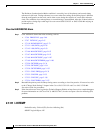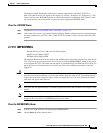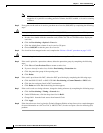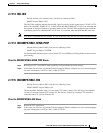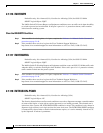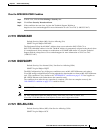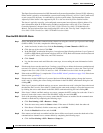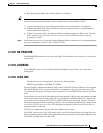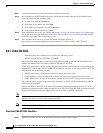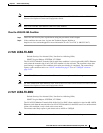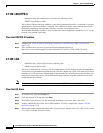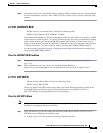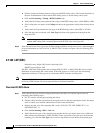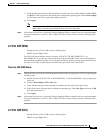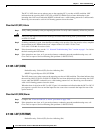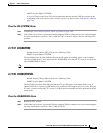
2-82
Cisco ONS 15310-CL and Cisco ONS 15310-MA Troubleshooting Guide, R7.0
Chapter 2 Alarm Troubleshooting
2.7.125 LCAS-RX-FAIL
Note For more information about Ethernet cards, refer to the Cisco ONS 15310-CL and Cisco ONS 15310-MA
Ethernet Card Software Feature and Configuration Guide.
Clear the LCAS-CRC Condition
Step 1 Look for and clear any associated equipment failures, such as the EQPT alarm, on the receive node or
transmit node.
Step 2 Look for and clear any bit error rate conditions at the transmit node.
Step 3 If no equipment or SONET path errors exist, ensure that the remote node has LCAS enabled on the
circuit by completing the following steps:
a. In node view, click the Circuits tab.
b. Choose the VCAT circuit and click Edit.
c. In the Edit Circuit window, click the General tab.
d. Verify that the Mode column says LCAS.
Step 4 If the column does not say LCAS, complete the “Delete a Circuit” procedure on page 2-155 and recreate
it in LCAS mode using the instructions in the Cisco ONS 15310-CL and Cisco ONS 15310-MA Ethernet
Card Software Feature and Configuration Guide.
Step 5 If the condition does not clear, log into the Technical Support Website at
http://www.cisco.com/techsupport for more information or call Cisco TAC (1-800-553-2447).
2.7.125 LCAS-RX-FAIL
Default Severity: Not Alarmed (NA), Non-Service-Affecting (NSA)
SONET Logical Objects: STSTRM, VT-TERM
The LCAS VCG Member Receive-Side-In Fail condition is raised against ML-100T-8 Ethernet cards
with LCAS-enabled VCG or software-enabled LCAS (SW-LCAS) VCG.
LCAS VCGs treat failures unidirectionally, meaning that failures of the transmit or receive points occur
independently of each other. The LCAS-RX-FAIL condition can occur on the receive side of an LCAS
VCG member for the following reasons:
• SONET path failure (a unidirectional failure as seen by the receive side).
• VCAT member is set out of group at the transmit side, but is set in group at the receive side.
• VCAT member does not exist at the transmit side but does exist and is in group at the receive side.
The condition can be raised during provisioning operations on LCAS VCGs but should clear when the
provisioning is completed.
Software-enabled LCAS VCGs treat failure bidirectionally, meaning that both directions of a VCG
member are considered failed if either transmit or receive fails. The LCAS-RX-FAIL condition is raised
on these VCG members when a member receive side fails due to a SONET path failure.
Step 1 Look for and clear any bit error rate conditions at the transmit node.
Step 2 If no equipment or SONET path errors exist, ensure that the remote node has LCAS enabled on the
circuit by completing the following steps:
a. In node view, click the Circuits tab.
b. Choose the VCAT circuit and click Edit.
c. In the Edit Circuit window, click the General tab.
d. Verify that the Mode column says LCAS.
Step 3 If the column does not say LCAS, complete the “Delete a Circuit” procedure on page 2-155 and recreate
it in LCAS mode using the instructions in the Cisco ONS 15310-CL and Cisco ONS 15310-MA Ethernet
Card Software Feature and Configuration Guide.
Step 4 If the condition does not clear, log into the Technical Support Website at
http://www.cisco.com/techsupport for more information or call Cisco TAC (1-800-553-2447).
0.0.1 LCAS-RX-FAIL
Default Severity: Not Alarmed (NA), Non-Service-Affecting (NSA)
SONET Logical Objects: STSTRM, VT-TERM
The LCAS VCG Member Receive-Side-In Fail condition is raised against ML-100T-8 Ethernet cards
with LCAS-enabled VCG or software-enabled LCAS (SW-LCAS) VCG.
LCAS VCGs treat failures unidirectionally, meaning that failures of the transmit or receive points occur
independently of each other. The LCAS-RX-FAIL condition can occur on the receive side of an LCAS
VCG member for the following reasons:
• SONET path failure (a unidirectional failure as seen by the receive side).
• VCAT member is set out of group at the transmit side, but is set in group at the receive side.
• VCAT member does not exist at the transmit side but does exist and is in group at the receive side.
The condition can be raised during provisioning operations on LCAS VCGs but should clear when the
provisioning is completed.
Software-enabled LCAS VCGs treat failure bidirectionally, meaning that both directions of a VCG
member are considered failed if either transmit or receive fails. The LCAS-RX-FAIL condition is raised
on these VCG members when a member receive side fails due to a SONET path failure.
Note For more information about Ethernet cards, refer to the Cisco ONS 15310-CL and Cisco ONS 15310-MA
Ethernet Card Software Feature and Configuration Guide.
Note ONS 15310-CL ML-100T-8-Series cards are LCAS-enabled.
Clear the LCAS-RX-FAIL Condition
Step 1 Check for and clear any line or path alarms using the procedures in this chapter.



